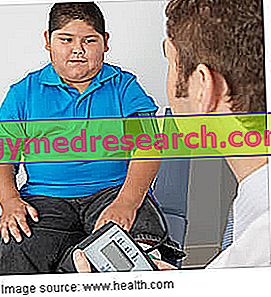Cholesterol and high cholesterol
Cholesterol is a steroid lipid of animal origin; it represents both a nutritional component (deriving for 30% of the total from food), and a molecule of endogenous synthesis (deriving for 70% of the total from intracellular production, especially at the level of the liver and intestine).

However, nowadays, thanks to a sedentary lifestyle and an unbalanced diet, cholesterol is a frequently in excess, a nutrient that predisposes the human being to the onset of metabolic diseases, even deadly.
Excess cholesterol in the blood is called hypercholesterolemia and it is as harmful as its clinical history is long; if it arose in the child and remained until adulthood, in all likelihood it would lead to the formation of atherosclerotic plaques already in early adulthood. Other factors that determine the severity of high cholesterol, both in adults and children, are:
- Quantity of total cholesterol (especially LDL + HDL)
- Quantity of total LDL (called bad cholesterol)
- Association of other metabolic diseases (hypertriglyceridemia, hypertension, reduced glucose / diabetes tolerance, etc.), obesity and smoking.
Many know that the maximum acceptable cholesterol level defined for adults is 200mg / dl ...
... but how much should it be for children?
Total cholesterol in children is considered NORMAL up to about 160mg / dl, although it is possible to witness significant inter- and intra-individual variations, deriving from: sex, age, developmental phase, physical activity, etc.
Causes of high cholesterol in children
A significant alteration in blood cholesterol levels in children may be the result of:
- Obesity
- Diet rich in saturated or hydrogenated fatty acids and cholesterol
- Sedentary lifestyle
- Congenital dyslipidemia, most frequently of familial hypercholesterolemia type; this pathology is based on the structural alteration of the hepatic receptors for the uptake of LDL lipoproteins, which affects the excessive increase of total cholesterol in the blood, up to 700mg / dl in homozygous subjects. Familial hypercholesterolemia occurs frequently with the deposit of xanthomas, visible and palpable, located at the subcutaneous and / or tendon level; the most serious complication of familial hypercholesterolemia that begins in children is early coronary thrombosis (lipid clot), which therefore appears already in the pediatric age.
NB . In case of hypercholesterolemia and / or hypertriglyceridemia associated with obesity in children it is recommended to perform an analysis of thyroid hormone levels; among these, the most compromised is T3 (especially in severe obesity), unlike TSH and T4 which remain almost unchanged.
Other causes of high cholesterol in children
The other causes of high cholesterol in children are of genetic origin; these are more or less important mutations in the expression of some locus that code for APO-proteins, or the intrinsic polypeptides of cholesterol transport lipoproteins (HDL, LDL, VLDL, KILOMICRONI). The most frequent are:
- Impairment of APO-E which results in hypercholesterolemia associated with hypertriglyceridemia with accumulation of IDL and residual particles ( indiscriminate hyperlipidemia )
- Excess of APO B-100 concentrations in VLDL and LDL lipoproteins ( familial combined hyperlipidemia ).
How is high cholesterol treated in children?
The cure for high cholesterol in children is not an easy topic and is still the subject of controversy; certainly the therapy must be chosen based on the importance of hypercholesterolemia and specific causes, even if physical exercise on the one hand (understood as a general movement) and nutritional balance on the other represent the two pillars of any treatment cholesterol lowering.
With regard to the use of drugs, however, the subject changes radically; the most competent bodies, such as the American Academy of Pediatrics, suggest to include drugs in child treatment starting (and not before) from 8 years; the choice is well reasoned, since we do not have sufficiently accurate data regarding any side effects that these molecules could have on even smaller children. On the other hand, as often happens, other experts believe that the moderation of blood LDLs plays such an important role as to ignore any contraindications even in children under 8 years, since the risk of coronary thrombosis due to high cholesterol is a factor of extremely insidious death.
It is essential to reiterate that the effects of a drug therapy against high cholesterol in children are not yet well known and some active ingredients cause many concerns about toxicity, overdosing or related side effects (such as niacin - vit. PP).
Ultimately, given and considered the heterogeneity of the cases related to high cholesterol in children, parents are advised to consult the specialist doctor who, based on their own knowledge and specific clinical picture, will choose whether or not to carry out further investigations necessary to establish the right cholesterol-lowering therapy.
NB . As mentioned, in any case of high cholesterol in children, the increase in general motor activity and the choice of a specific diet represent two essential factors for the improvement and the possible resolution of the dyslipidemia in question.
Bibliography:
- The obese child and complications - C. Maffeis - SEE Florence - page 27
- Principles of physiology of Berne & Levy - Matthew N. Levy, Bruce M. Koeppen, Bruce A. Stanton - Elsevier Masson - pag 618



